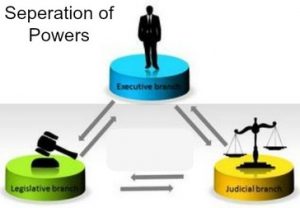The doctrine of the separation of powers finds its roots in the ancient world, where the concepts of governmental functions, and the theories of mixed and balanced government, were evolved. These were essential elements in the development of the doctrine of the separation of powers. Their transmission through medieval writings, to provide the basis of the ideas of constitutionalism In England, enabled the doctrine of the separation of powers to emerge as an alternative, but closely related, formulation of the proper articulation of the parts of government.
The power to govern should be distributed between the Parliament, the Executive and the Judiciary to avoid one group having all the power. Each group should work within defined areas of responsibility so that each keeps a check on the actions of the others.
The principle of separation of powers deals with the mutual relations among the three organs of the government, namely legislature, executive and judiciary. The doctrine of the separation of powers tries to bring exclusiveness in the functioning of the three organs and hence a strict demarcation of power is the aim sought to be achieved by this principle. This doctrine signifies the fact that one person or body of persons should not exercise all the three powers of the government.Its based on checks and balances of government functions.
Main features of separation of power are:-
- That the same persons should not form part of more than one of the three organs of Government, e.g. the Ministers should not sit in Parliament;
- One organ of the Government should not control or interfere with the exercise of its function by another organ, e.g. the Judiciary should be independent of the Executive or that Ministers should not be responsible to Parliament;
- One organ of the Government should not exercise the functions of another, e.g. the Ministers should not have legislative powers.
India follows constitutional democracy which offers a clear separation of powers. The judiciary branch is fairly independent of the other two branches with the power to interpret the constitution. Parliament has the legislative powers. Executive powers are vested with the President who is advised by the Union Council of Ministers headed by the Prime Minister. The constitution of India vested the duty of protecting, preserving and defending the constitution with the President as common head of the executive, parliament, armed forces, etc. not only for the union  government but also the various state governments in a federal structure. All three branches have “checks and balances” over each other to maintain the balance of power and not to exceed the constitutional limits.
government but also the various state governments in a federal structure. All three branches have “checks and balances” over each other to maintain the balance of power and not to exceed the constitutional limits.
- President can set aside a law passed by the legislative or an advise given by the Union Council of Ministers when it is inconsistent with the constitution of India.
- Even president accepts a law passed duly by the legislative, it can be repealed by the Supreme Court after a fair trial if it is against the Basic structure of the constitution. Any citizen of India can approach the Supreme Court directly to repeal the unconstitutional laws made by the legislative or executive.
- President can be impeached after conducting a fair trial by the parliament for his unconstitutional orders/decisions.
- President can be asked to step down by the judiciary for his unconstitutional orders/decisions on the grounds of losing eligibility criteria of the president.
- Parliament can impeach judges of Supreme Court and High Courts of states for their incompetence and malafides. Higher bench of judges can set aside the incorrect judgement of smaller bench of judges to uphold the constitution.
CGPCS Notes brings Prelims and Mains programs for CGPCS Prelims and CGPCS Mains Exam preparation. Various Programs initiated by CGPCS Notes are as follows:-